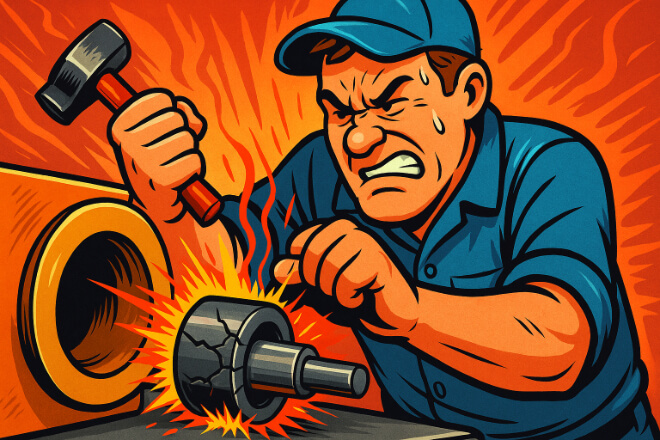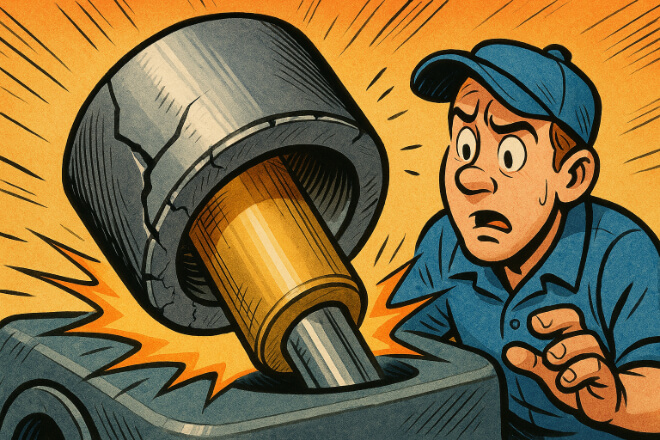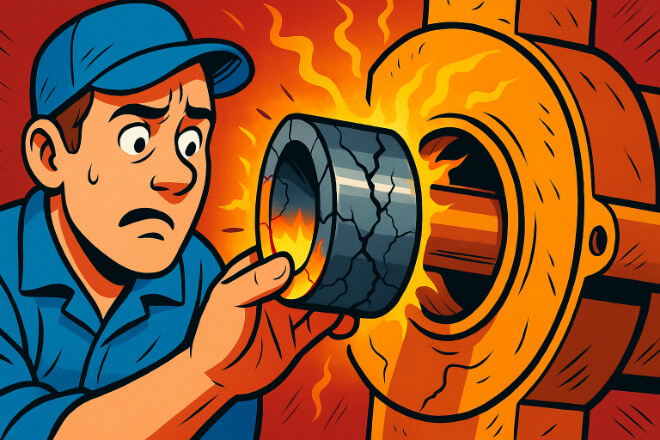Tungsten carbide bushings are essential components in many industrial applications due to their excellent 내마모성 내구성이 뛰어납니다.
However, despite their 강인함, tungsten carbide bushings can experience premature wear if not properly maintained or installed.
In this blog, we will explore the common causes of premature wear in tungsten carbide bushings, how these issues can be prevented, and the steps companies can take to maximize the lifespan of their bushings.
Reason 1: Lack of Proper Lubrication

Lubrication is crucial in reducing friction between the tungsten carbide bushing and the mating component, such as the shaft or housing.
Without proper lubrication, the friction increases, leading to excessive wear and heat generation.
1). Why Lubrication is Important:
Reduces Friction: Lubricants create a thin film between the bushing and the shaft, reducing direct contact and minimizing friction.
Prevents Overheating: Friction can generate significant heat, which accelerates wear. Lubrication helps dissipate this heat, protecting the bushing from damage.
Improves Efficiency: Proper lubrication ensures smooth operation, leading to increased efficiency and extended service life.
2). Common Causes of Insufficient Lubrication:
Lack of Regular Maintenance: Inadequate checks on lubrication levels can lead to insufficient lubrication.
Wrong Type of Lubricant: Using the wrong lubricant for the application can affect performance. For example, using low-viscosity oil in high-load applications can result in inadequate lubrication.
Inconsistent Application: If lubrication is not evenly applied to the bushing, certain areas may experience excessive friction.
3). Solution:
Use the Right Lubricant: Ensure that the lubricant is compatible with tungsten carbide and suitable for the operating conditions.
Regular Maintenance: Establish a regular maintenance schedule to check lubricant levels and reapply when necessary.
Even Lubrication Distribution: Apply lubricant evenly across the bushing and shaft for consistent performance.
Reason 2: Excessive Load or Overloading

Tungsten carbide bushings are designed to withstand high loads, but exceeding the recommended load limits can cause premature wear and even failure of the bushing.
Overloading the bushing can cause stress concentrations, which lead to surface wear, cracking, or deformation.
1). Why Load Matters:
Stress Concentrations: High loads can create stress points on the bushing, causing cracks or uneven wear.
Material Deformation: Excessive load can cause the bushing material to deform, affecting its shape and fit within the housing.
2). Common Causes of Overloading:
Inappropriate Design: Using bushings that are not rated for the required load can result in premature failure.
Improper Operation: Operating equipment at higher loads than the design specifications can put excessive stress on the bushing.
Lack of Load Monitoring: Failure to monitor the load on equipment can lead to overloading situations that cause damage.
3). Solution:
Use the Correct Bushing Design: Always select bushings that are rated for the expected load in the application.
Monitor Load Conditions: Implement load monitoring systems to ensure that the bushing is not subjected to excessive stress.
Optimize Operational Practices: Train operators to recognize and avoid situations where excessive load is applied.
Reason 3: Improper Installation or Misalignment

Misalignment of the shaft and housing during installation is a significant cause of premature wear in tungsten carbide bushings.
If the bushing is not aligned properly, it can lead to uneven pressure, increased friction, and excessive wear.
1). Why Alignment is Crucial:
Even Load Distribution: Proper alignment ensures that the load is distributed evenly across the bushing, preventing localized wear.
Reduced Friction: Misalignment can cause the bushing to rub against certain areas of the shaft or housing, leading to excessive friction and wear.
Prevents Stress: Alignment prevents unnecessary stress that can lead to cracking, chipping, or material degradation.
2). Common Causes of Misalignment:
Incorrect Handling During Installation: Improper handling of the bushing or misaligned components during installation can cause the bushing to be installed incorrectly.
Wear Over Time: After extended use, slight shifts in components can cause misalignment, even if they were initially installed correctly.
Poor Manufacturing Tolerances: Manufacturing defects in the bushing, housing, or shaft can result in misalignment during installation.
3). Solution:
Use Proper Alignment Tools: Use alignment tools such as laser alignment systems or dial indicators to ensure accurate alignment during installation.
Ensure Proper Installation Procedures: Follow manufacturer guidelines for installation, and check alignment carefully before operation.
Regular Inspections: Perform regular maintenance and checks to detect any misalignment or wear that could lead to excessive stress on the bushing.
Reason 4: Temperature Variations

Tungsten carbide bushings can experience premature wear if there are significant temperature fluctuations during operation.
Both overheating and cold temperatures can affect the bushing’s performance and longevity.
1). Why Temperature Matters:
Thermal Expansion: Tungsten carbide expands and contracts with temperature changes. Rapid temperature changes can cause stress on the material, leading to cracks or excessive wear.
Lubrication Breakdown: High temperatures can cause lubricants to degrade faster, reducing their effectiveness in reducing friction.
Bushing Deformation: Excessive heat can lead to thermal deformation of the bushing, affecting its fit and performance.
2). Common Causes of Temperature Issues:
Excessive Heat: Operating machinery at high temperatures without proper cooling can cause overheating.
Cold Environments: Extremely cold environments can cause the bushing material to contract, which may lead to cracking when subjected to load.
3). Solution:
Control Operating Temperature: Ensure that the equipment is operating within the recommended temperature range.
Use Heat Shields or Cooling Systems: Install heat shields or cooling systems to regulate temperature around the bushing and prevent overheating.
Temperature Monitoring: Implement temperature sensors to monitor the bushing and housing for abnormal temperature fluctuations.
Reason 5: Poor Material Quality or Manufacturing Defects

The quality of the tungsten carbide material itself is a key factor in preventing premature wear.
Defects in the material or manufacturing process can cause weak points in the bushing, making it more susceptible to wear, cracking, or failure.
1). Why Material Quality is Crucial:
Consistency: High-quality tungsten carbide should have consistent hardness and wear resistance throughout the bushing.
Defects: Any defects in the material, such as voids, cracks, or improper bonding, can weaken the bushing and lead to premature failure.
2). Common Causes of Material Defects:
Poor Sintering Process: Inadequate sintering during manufacturing can lead to inconsistent material properties.
Incorrect Binder Content: The binder content affects the 강인함 of the tungsten carbide. Incorrect binder ratios can lead to brittleness or reduced 내마모성.
Substandard Manufacturing: Poor manufacturing tolerances or quality control can result in defects that affect the bushing’s performance.
3). Solution:
Ensure Quality Control: Work with reputable suppliers who maintain strict quality control processes during manufacturing.
Inspect the Material: Before installation, inspect the bushing for any visible defects or inconsistencies in the material.
Verify Sintering and Binder Content: Ensure that the tungsten carbide is properly sintered and the binder content is optimized for the application.
Common Causes of Premature Wear in Tungsten Carbide Bushings
| Cause | Effect | 해결책 |
|---|---|---|
| Lack of Proper Lubrication | Increased friction, wear, and heat generation | Use appropriate lubricants and regular maintenance |
| Excessive Load | Stress concentration, deformation, and wear | Monitor load limits and use correctly rated bushings |
| Improper Alignment | Uneven pressure, excessive friction, wear | Use alignment tools and verify before installation |
| Temperature Variations | Cracking, deformation, and wear | Control temperature and use cooling or heat shields |
| Poor Material Quality | Weak points, cracking, premature wear | Source high-quality tungsten carbide with strict quality control |
결론
Premature wear in tungsten carbide bushings can be avoided by addressing the common causes such as lack of lubrication, excessive load, misalignment, temperature variations, and poor material quality.
By following best practices and maintaining regular maintenance, companies can extend the lifespan of their bushings, reducing downtime and operational costs.
Identifying and addressing these causes early can lead to more reliable and efficient machinery in the long run.
회사에 대한 자세한 내용을 알고 싶으시면 언제든지 문의해 주세요. 문의하세요.
